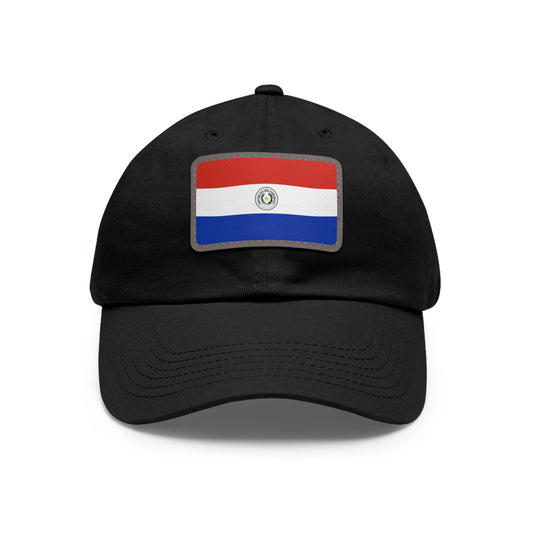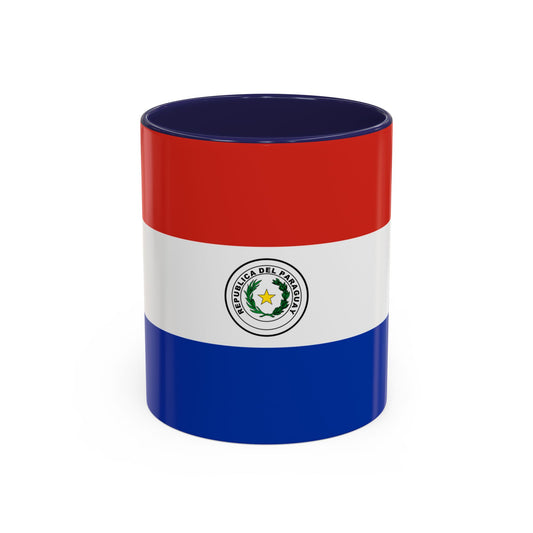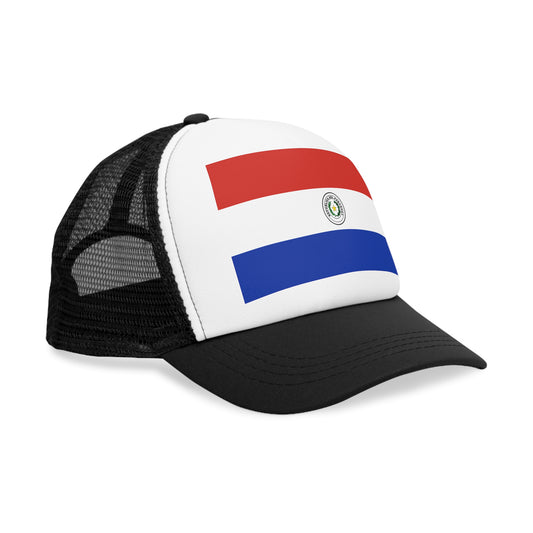-
Paraguay Sweatshirt
Regular price $34.15 USDRegular priceUnit price / per -
Paraguay Flag Sweatshirt
Regular price $34.15 USDRegular priceUnit price / per -
Paraguay Pillow
Regular price $22.65 USDRegular priceUnit price / per -
Paraguay Backpack
Regular price $59.79 USDRegular priceUnit price / per -
Paraguay Leather Patch Hat
Regular price $18.85 USDRegular priceUnit price / per -
Paraguay Mug
Regular price $11.65 USDRegular priceUnit price / per -
Paraguay Trucker Cap
Regular price $14.90 USDRegular priceUnit price / per -
Paraguay Hoodies
Regular price $34.40 USDRegular priceUnit price / per -
Paraguay T-shirts
Regular price $22.79 USDRegular priceUnit price / per -
Paraguay Flag Hoodies
Regular price $34.40 USDRegular priceUnit price / per -
Paraguay Flag on T-shirt
Regular price $22.79 USDRegular priceUnit price / per
Collection: Paraguay
The Paraguay flag symbolizes national pride and identity for the people of Paraguay. Its design and colors hold significant meaning, representing the country's history and values. We will explore the various aspects of the Paraguay flag, including its design, historical context, symbolism, current relevance, and some interesting anecdotes related to its use.
Overview of the Paraguay Flag's Design and Colors

The national emblem of Paraguay showcases a unique tri-color scheme consisting of three horizontal bands: red at the center, flanked by white, and then blue. These colors are visually striking and imbued with deep national significance. The central focus of the flag, and what truly sets it apart, is the presence of the country's coat of arms placed directly in the middle of the red stripe. This emblematic feature distinguishes the flag from many others around the world.
In an unusual twist that adds to the flag's distinctiveness, the Paraguay flag features a different emblem on each side. On the obverse (front) side, the coat of arms showcases a circular seal with the national motto “Paz y Justicia” (Peace and Justice) inscribed. Inside this seal, a lion stands before staff and the Phrygian cap, symbols deeply rooted in liberty and republican values. The flag's reverse side displays the treasury's seal, which includes a lion and the phrase “Paz y Justicia” as well, but with the addition of a circle inside which a green wreath surrounds a yellow five-pointed star. This site symbolizes the nation's economic strength and prosperity.
The choice of colors for the Paraguay flag is loaded with symbolism. Red represents the blood shed for independence, signifying courage and bravery. White symbolizes peace and unity among Paraguayans, serving as a reminder of the importance of cohesion and harmony. Lastly, blue stands for liberty, a nod to the skies under which the country declared its sovereignty and continues to thrive. Together, these elements form a flag and a narrative of Paraguay's journey, values, and aspirations.
Historical Context: Adoption and Evolution of the Flag
The flag of Paraguay, as we recognize it today, was officially adopted on November 25, 1842, marking a significant chapter in the nation's history. Its adoption followed Paraguay's declaration of independence from Spanish colonial rule in 1811. This pivotal moment set the stage for creating a symbol that would encapsulate the nation's values, aspirations, and newfound sovereignty. The journey to the current design was characterized by a desire to reflect the country’s unique identity and republican values, a task that culminated in the flag’s distinctive characteristics and symbolism.
Over the years, the Paraguay flag has experienced modifications that have subtly shaped its meaning and representation. While the fundamental elements have remained consistent—the red, white, and blue color scheme, along with the incorporation of national symbols—the specific details and arrangements of these symbols have evolved. This evolution reflects the country's historical trajectory, including its struggles and achievements, changing political landscape, and ongoing quest to define its place in the global community.
The uniqueness of the Paraguay flag, being the only national flag in the world with different emblems on its obverse and reverse sides, highlights the nation's complex history and the multifaceted aspects of its national identity. Adopting two separate emblems signifies the importance of the nation's commitment to peace and justice, represented on the obverse, and its economic aspirations and prosperity, symbolized on the reverse.
This flag's adoption and subsequent evolutions encapsulate a national consolidation, reflection, and ambition period. It stands as a testament to Paraguay's enduring spirit, resilience in the face of adversity, and unwavering commitment to liberty, peace, and justice. Through each change, the Paraguay flag has remained a steadfast symbol of the nation’s pride, a banner under which its people unite and celebrate their shared heritage and ongoing journey.
Symbolism Embodied in the Paraguay Flag

The symbolism of the Paraguay flag profoundly reflects the country’s core values, history, and aspirations. Each element, from the colors to the specific symbols on both the obverse and reverse sides of the flag, is imbued with significant meaning that speaks to the heart of Paraguayan identity.
The red stripe symbolizes the bravery and courage of the Paraguayan people, particularly in their fight for independence. It reminds us of the sacrifices made by those who came before, ensuring that the spirit of patriotism is vividly kept alive in the national consciousness. White, as the central band, represents the purity and peace that forms the foundation of the country's ethos. It underscores Paraguay's importance of unity and harmony, serving as a beacon of hope for a cohesive national identity. Blue signifies the hard-won liberty and justice that continue to be cherished as pillars of the Paraguayan Republic.
On the obverse side of the flag, the national coat of arms with the lion, the liberty cap, and the inscription "Paz y Justicia" encapsulates the republic's commitment to maintaining peace and ensuring justice for all its citizens. The lion, a symbol of courage and power, guarding the liberty cap underscores the value placed on freedom and protecting individual rights within the nation. The flag's reverse side, with its depiction of the treasury seal, highlights the significance of economic prosperity and the stewardship of the nation’s resources. The yellow star, surrounded by a green wreath, is a beacon of independence, illuminating the path towards honor and victory.
Together, these symbols craft a narrative of resilience, unity, and ambition. They serve as a reminder of past struggles and triumphs and as a guide for future generations. The flag of Paraguay, thus, is more than just a national emblem; it is a living testament to the enduring spirit and values of the Paraguayan people.
The Current Relevance of the Paraguay Flag
Today, the Paraguay flag maintains a vibrant role in the nation's cultural and political landscape, visually representing its enduring values and unity. Its presence is a constant at many events, from significant national holidays like Independence Day to public gatherings and sports competitions, where citizens proudly display and honor it. In educational settings, the flag is used as a pedagogical tool, educating young Paraguayans about their country's history and the importance of national pride. Government buildings and official residences also fly the flag, underscoring its status as a symbol of authority and governance.
In the military context, the flag's role is equally profound. It adorns military uniforms, equipment, and installations, reflecting the deep respect and loyalty the armed forces hold for the nation. During military parades and ceremonies, the flag is often at the forefront, carried with great honor and dignity by service members. This practice pays homage to the sacrifices made for the country's independence and sovereignty and reinforces the flag's role in uniting Paraguayans under a standard banner of national identity.
Although discussions about its design and symbolism occasionally emerge, these debates testify to the flag's significance in the public discourse, engaging citizens in a shared conversation about their national identity and values. Far from diminishing its importance, these discussions deepen the connection between Paraguayans and their flag, ensuring its continued relevance in the fabric of Paraguayan society.
Additional Facts: Protocols and Anecdotes Surrounding the Paraguay Flag
Paraguay has a set of unique protocols concerning the display and handling of its flag, reflecting the nation’s deep respect for this emblem of sovereignty. A notable practice involves the specific manner in which citizens are expected to pay homage to the flag. During official ceremonies or when the national anthem is played, individuals show their respect by placing their right hand over the heart, symbolizing loyalty and patriotism. Unlike many countries, Paraguay has a distinct tradition regarding the positioning of the flag; it is never flown at half-mast. This custom underscores a profound respect for the symbols of independence and the unyielding spirit of the Paraguayan people.
One historical anecdote highlighting the flag's significance involves its role during the Chaco War against Bolivia. Paraguayan soldiers, embodying the spirit of national pride and resilience, would carry the flag into the heart of battle. This act was symbolic and served as a rallying point, instilling courage and unity among the troops. It underscored the flag's role as a talisman of courage and determination, embodying the collective will to defend the nation's sovereignty.
These traditions and stories illustrate the Paraguay flag's depth of meaning for its people. Far from being a mere national symbol, it is woven into the very fabric of Paraguay's national identity, representing a beacon of unity, resilience, and unwavering patriotism.






















